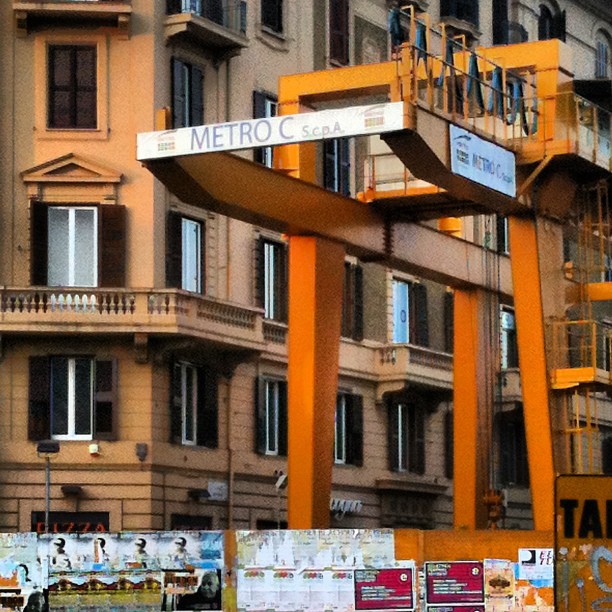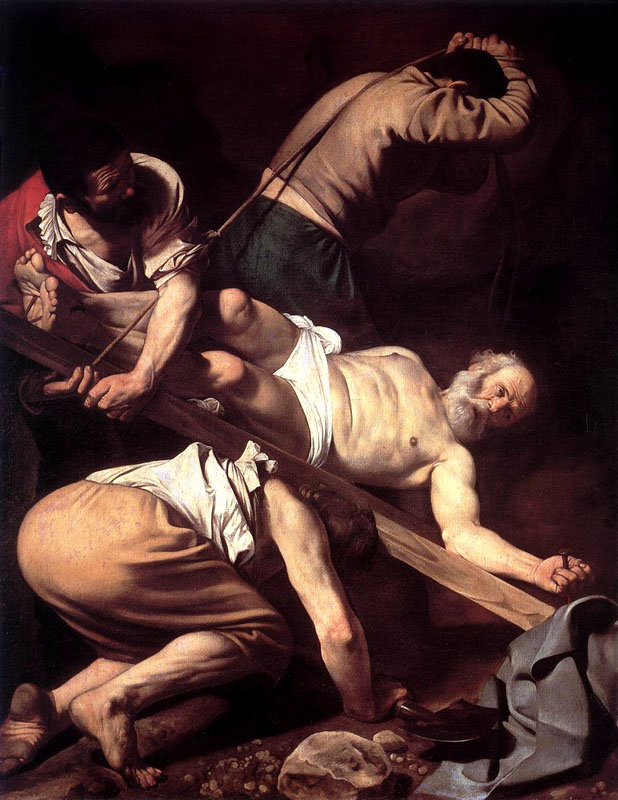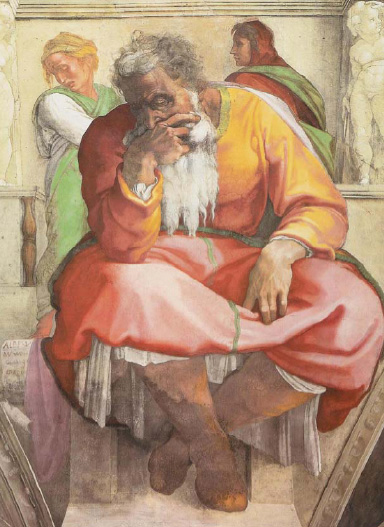[NB: this is a slight detour from the usual, Olympic Weightlifting related drivel. But its relevance lies in the fact that I’ve long had to rely on Rome’s dismal public transit system to get to the city’s gym up in Prati. When I lived in Testaccio I was dependent on the 23 bus, which runs with approximately the same frequency as major ecumenical councils. In San Giovanni I’ve been fortunate enough to have a metro line nearby (one of city’s many two lines), although some would argue that “fortunate” is never a word to use in reference to public transit in Rome. But I digress. Feel free to pop over here for some Klokov videos.]
It is now midway through 2013, and the mythical “C line” that was supposed to open in 2009 2010 2011 2012 this year has been delayed once more. The construction sites are covered in strata of posters that could be examined and excavated like an ancient city. Indeed, by this point the construction sites themselves are likely to be considered pieces of history, resulting in a feedback loop of being unable to do work without requisite archeological permits for the machinery itself. There’s almost something poetically beautiful about the sites, standing vacant and unused, like an abandoned church or the crumbling ruins of a temple. Almost. The poetic beauty runs thin when you realize that you’ve been waiting 45 minutes for a bus in a city so plagued with traffic problems that it is often faster to walk places than rely on public transit.
But to understand the problems is to understand Rome. This requires an examination of the C line’s long and storied history, which in many ways is the history of Rome itself. What follows, then, is a brief timeline of the starts and (more often) stops of the mythical “C line”.
Rome’s Metro C Line: A Short History
- 753 BC: Shortly after Rome is founded by the twins Romulus and Remus, Romulus kills his brother over a dispute on where the planned Metro C line should go. This begins the first in a series of long setbacks for the projected metro line.
- 44 BC: Marcus Junius Brutus and Gaius Cassius Longinus, frustrated over long wait times for buses and the lack of a functioning metro system, take out their frustration by plotting and then carrying out the assassination of Julius Caesar.
- 27 BC: Augustus becomes Emperor of Rome. Among his first orders is a command to resume work on the C line. Ancestors of today’s ATAC transportation workers, indignant at being told how to do their job, promptly go on strike.
- 42 AD: Peter the Apostle arrives in Rome. He spends the entirety of the first day waiting for a 23 bus, testing the absolute limits of his Christian patience and forcing him to consider converting to Mithraism.
- 64 AD: The Great Fire of Rome is started when a striking ATAC worker tosses a cigarette butt into a pile of dried Reggae posters that adorned one of the Metro C construction sites. Emperor Nero, fearing a backlash, blames the C line’s delays (and the fire) on the Christians. The enraged populace, sick of wooden-cart traffic jams, begins persecuting the religion.
- 67 AD: Saint Peter, held up as a scapegoat for continuing delays to the C line, is crucified. ATAC employees hired to help with the execution go on strike midway through the raising of the cross, leaving Peter to be crucified upside down.
- 132 AD: After a brief period of activity, work is delayed when the construction team runs into a conflict over the site of emperor Hadrian‘s Athenaeum, which is built directly in the C line’s path. On investigation, it is discovered that neither construction team had successfully completed all 753 forms (in triplicate) required for a building permit in Rome. Chaos ensues.
- 312: Emperor Constantine, after defeating Maxentius at the Battle of the Milvian Bridge, becomes the sole ruler of Rome. Constantine’s victory is aided by the fact that over half of Maxentius’s army was unable to attend the battle due to a transportation strike.
- 410: Rome is sacked by Alaric I, king of the Visigoths. Widespread looting is somewhat kept in check due to the poorly-connected public transit system. In light of this, Alaric is said to have proclaimed, on his departure from the city, “Even we barbarians could’ve built a metro by now, for the love of Tiwaz.”
- 800: Charlemagne is crowned emperor of Rome in St Peter’s. He briefly tries to resurrect work on the C line but abandons it after his scribes realize that the paperwork requires use of a photocopier, which will not be invented for several hundred years. On trying to explain this fact to a government official, the scribes are referred to a nonexistent address.
- 1309: Pope Clement V, frustrated at waiting for the C line, moves the Papacy to Avignon. He is delayed en route by a baggage strike at Fiumicino.
- 1505: Pope Julius II calls a young Michelangelo to Rome with the promise of work adorning the eventual C line stations with a series of sculptures. The ambitious project is soon abandoned when the pope decides to have Michelangelo paint the Sistine Chapel ceiling instead.
- 1585: As part of his redesign of Rome’s street plan, Pope Sixtus V includes plans for several conveniently placed metro stops. Unfortunately, the documents are rejected when it is noted that they are not accompanied by the requisite marca da bollo. Papal aides try to rectify the problem but no one in Rome will give them change for a €50 bill.
- 1760: Giovanni Battista Piranesi publishes his series of etchings titled “Vedute di Roma” (The Views of Rome). Several images include long-abandoned Metro C construction sites and striking ATAC workers.
- 1886: On July 3rd, the first true forerunner of the modern automobile, the Benz Patent-Motorwagen, is unveiled to the public in Germany. Inexplicably, later that afternoon Rome experiences its first traffic jam, parts of which continue to this day.
- 1955: Rome’s B line Metro opens, connecting the city’s outskirts to the further outskirts. By the afternoon of the metro’s first day, every single metro car is covered in graffiti.
- 1960: Rome hosts the 1960 Summer Olympic Games. In an effort to spur new work on the Metro C line, the Games organizers introduce two new events: “competitive tunnel boring” and “100-meter track-laying sprints.” The initiative fails when all the competitors spontaneously go on strike.
- 1962: The Second Vatican Council takes place, in which the Catholic Church officially declares the Metro C to be a distinct branch of limbo. Several high-ranking church officials, including future Pope John Paul II, miss the proceedings while riding a 23 bus stuck in a traffic jam.
- 1980: Parts of the A line begin service. As part of an innovative, unusual, and not entirely understood design feature, the distance required to walk out of certain Metro stations is actually longer than the distance between stations.
- 1990: The B line is extended, connecting the metro to parts of the city no one knew they wanted to go to. Renewed plans also begin for a highly ambitious C line.
- 2006: Archeological investigations to assess the new C line’s feasibility begin on August 1 and end later that day when the entire city goes on its annual August vacation.
- 2007: After discovering, to nobody’s surprise, that there is an entire Ancient City under the modern one, the plans for the C line are significantly reduced. The new route is scaled back from a projected 31 stations to just 2, and will run for roughly 850 meters between Monte Compatri-Pantano and Graniti. Projected yearly ridership is 6 people (including 2 drivers).
- 2012: Unable to complete the necessary paperwork for a second station, the project is once again scaled back. It is now determined that the entire C line will consist of one station with a single train that will transport passengers from one end of the station to the other. The planned train will be fully automated, although ATAC workers demand that monthly strikes are written into its computer code.
- 2013: Planned first section, due to open years ago, still currently under construction. Projected date of completion: August 36.
- 2014: Second section projected date of completion: February 30.
- 2015: Third section projected date of completion: Durin’s Day.
- 2020: Fourth section projected date of completion: Judgment day.
And now, back to my hero Klokov:





Pingback: Anonymous
A Tour de Force, David. Bravo!
Brilliant! Although it was difficult to explain why I was laughing to a ten-year-old. S: “Well, you see the joke depends on knowing about the C line and the mythical foundations of Rome.” Child: eh?
Maybe it would help if you recreated the experience of a Roman bus. Try putting the child in a moderately warm oven with a pile of old gym socks for 30-40 minutes. This should help them understand.
The Piranesi illustration of Metro C!! hahhahahahahaha!!
F***ing hilarious, man. Thanks for a great start o’ day.
Pingback: Ritardi della C: ironie planetarie // Comitato Metro X Roma
I was dependent on bus 23 as well but I had Powerful Cheap Smartphone Technology in my hands, so I was able to check for waiting times of the bus stop nearby on the ATAC website http://muovi.roma.it
Amazing. Have now shared with the entire office. Well, the people who have managed to arrive in the office by 9 am after semi-successfully navigating the bowels of Rome’s public transport system on this fine strike-free Thursday.
Ha ha ha! I love history and this would be my favorite
Nice article indeed! I am a Roman and I travelled all over Europe. Going to work every day by underground is a frightening experience if one makes a comparison to the average public transportation systems seen elsewhere, even in Milan or Naples. We have just two lines, where dirty trains packed with people, beggars and pickpockets ride with third-world frequencies. No ticket control and customer service, rude and unhelpful personnel are a rule and not an exception. This is what we offer to foreign tourists and fellow Romans are so used to this that they don’t even complain anymore, even if they have to pay €35 per month to ride the underground or use the bus network. It took 50 years to get to this stage, so we can easily afford to wait another quarter of century. And there are many people who are interested in the Metro C more than the Romans themselves because they will get a profit, In fact, the average Roman knows that public transport is not efficient and comfortable and prefers using his car, fully aware that he will need to wake up at 5 o’clock every morning to avoid the rush hour traffic jams caused by the other Romans who prefer using their cars instead of the public transport because it is not efficient and comfortable. Easy, isn’t it?
Wait for the 23 bus: in neapolitan “Smorfia” for the Lotto play, it means hasshole!
That is LUCK!
Here are also a roman citizen! We are very stressed from endless works and scaled back projectes!!! Help us…
😦
I love the history of Rome you have there. I watch the Spartacus series all the time.
Buy a bike.
Awesome and hilarious, complimenti 🙂
This is positively beautiful.
Absolutely fantastic…..well written! Anyone who lives in Rome will get a good laugh from this article. Coming to Rome and wondering why the Metro C line is still not open….keep reading!
Bravo! This article just made my day. As another foreigner living in Italy I can tell you that it’s not just Rome! Welcome to Italy.
Oh my goodness. This post is golden. I just got back from a trip to Italy that included four nights in Rome, and, as a history major, this post had me cackling loudly at every date. Thank you for the laughs!!!
Reblogged this on Life in Rome: The good, the bad, the hilarious and commented:
This is the funniest thing I’ve read about the C Line…and Rome in general for a long time! Enjoy!
This is amazing! Rock on. Sharing this for sure!
Brilliant!! Made me laugh through my metro ride (A line of course).
Pingback: How to Buy a Bus Ticket in Rome - An American in Rome
Pingback: Ritardi della C: ironie planetarie | Blog di pgnrcr